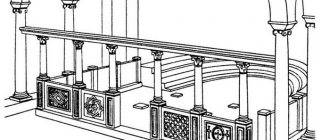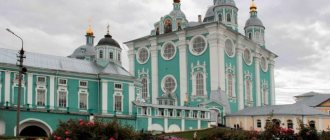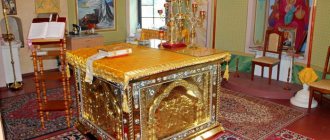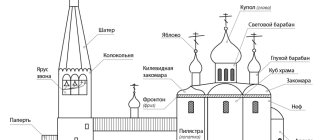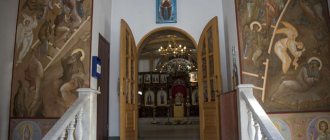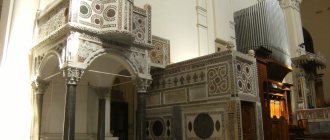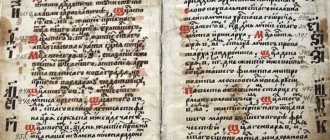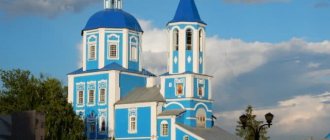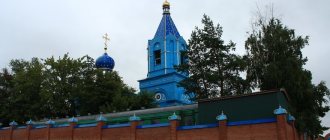History of the development of the iconostasis.
Also on the topic:
ORTHODOX WORSHIP
The formation of the iconostasis has a long history. In early Christian churches, the altar was separated from the temple itself by a woven curtain or barrier, which was either a low barrier wall or a series of columns with an architrave, which in the Byzantine tradition is usually called a templon. The oldest literary source reporting the existence of an altar barrier belongs to Eusebius of Caesarea (c. 260–340). He says that in the temple built in Tire in the 4th century, the altar was separated from the rest of the space by a carved fence. Considerably ancient, according to many researchers, is the use of woven curtains. By analogy with the curtain of the Old Testament temple, they separated the “Holy of Holies” of the church - the altar - from the place of meeting of believers, serving as an external sign of the hierarchy of parts of the temple. In the letters of the Apostle Paul, the Old Testament veil received a New Testament interpretation and was likened to the flesh of Christ, and therefore a cross began to be depicted on it, which later became an integral part of the decoration of the altar barriers.
Early Byzantine barriers consisted of marble barriers and columns carrying an architrave-templon decorated with an image of a cross. On the side of the altar behind it there was a curtain, which was drawn and drawn back at certain moments of the service. Such barriers, being an integral part of the architectural ensemble of the temple, highlighted the altar, emphasizing its significance as a place for performing the sacrament. Separating the altar from the naos, the curtain, barrier, and later the iconostasis served as the boundary between two worlds: the above and below, visible and invisible, and were intended to express their indissoluble connection. The material barrier symbolized the existence of an “immaterial iconostasis,” understood in the Orthodox tradition as a collection of saints, heavenly witnesses, proclaiming to the world what is “beyond the flesh.”
Also on topic:
ICON
The historical path of transforming the altar barrier into a high iconostasis is connected precisely with the consistent disclosure of this idea. Already in the 6th century. Emperor Justinian in the church of St. Sophia placed relief images of the Savior, the Mother of God, apostles and prophets on the templon of the altar barrier. In the post-iconoclast period, starting from the 9th century, the installation of icons on templons was already practiced quite widely. For the 12th century. the decoration of the Byzantine templon with a row of icons became ubiquitous. By this time, the iconostasis had taken the form of a portico with columns and free space between them. Icons were placed on a templon or hung from it. Sometimes large icons were placed in the intercolumnae of the portico. These were, as a rule, icons of the Savior, the Mother of God and the holy temple. Above the royal doors was placed the main icon - “Deisis” (Greek prayer, in Russian the word was fixed in the form “Deesis”), depicting on one board Christ and the Mother of God and John the Baptist addressed to him with prayer. The Byzantine barrier could have from one to three rows of icons, among which there were images of prophets and Christian holidays.
The type of altar barrier that developed in Byzantium passed to Rus', where it gradually underwent a number of significant changes that turned it into a high iconostasis. According to field studies in Russian churches of the 11th–12th centuries. There were two types of barriers - with a continuous templon, which covered the entire temple, and with a shortened templon, which covered only the central altar opening. Templon, in Russian translation “tyablo”, served primarily for fastening the curtains, which covered the entire altar space by almost half the height. The fundamental difference between both types and Byzantine barriers was the absence of columns in the composition and the installation of the templon at a considerable height. Subsequently, these features largely predetermined the transformation of the pre-Mongol barrier into a high iconostasis.
Also on topic:
ORTHODOX ICON
The high height of the templon and the absence of vertical divisions in Russian altar barriers provoked the filling of the void formed between the low barrier and the templon. The oldest monument known to us, in which an iconostasis was installed, consisting of a large-scale “Deesis” and the royal doors, dates back to 1360–1361 (the Church of Fyodor Stratilates on the Stream in Novgorod). Here, to fasten the Deesis, another lower panel appeared. In turn, the Byzantine templon turned into the upper table. There was no local row in this iconostasis.
Regarding the development of the Russian iconostasis in the 15th century. There are two hypotheses. According to the first, a high three-tiered iconostasis, including a Deesis rank, a festive and semi-figured prophetic row, was created in Moscow with the direct participation of Theophanes the Greek. According to the second hypothesis, the formation of the high iconostasis went through two stages. At the first stage, the iconostasis consisted of a Deesis and a festive row. In the 15th century In the workshop of Andrei Rublev, an iconostasis was created for the first time, including a semi-figured prophetic row. The emergence of a new type of iconostasis is associated with the hesychasm movement and the peculiarities of worship according to the Jerusalem Rule, introduced in Rus' by Metropolitan Cyprian.
In the 16th century a new row is added to the iconostasis - the forefathers' row. With its appearance, the classic type of five-tier iconostasis finally emerged. However, the increase in the number of rows and height of the iconostasis does not stop there.
Since the beginning of the 17th century. Above the ancestral row, a tier of images of seraphim and cherubim increasingly appears. In the second half of the 17th century. the so-called pyadnichnaya row (icons the size of a “span”, i.e. a hand). Presumably, its appearance is connected with the decision of the Council of 1666–1667, which condemned the practice of parishioners bringing their own icons to the temple, because of which “everyone prays to his own icon in different countries...”. The council decided to give the icons to the temple irrevocably, and, apparently, they began to be placed above the local row to ensure proper veneration of the images. In the second half of the 17th century. a passionate row (icons depicting the passion of Christ) appeared in the iconostasis, as well as a cross with the image of the Crucifixion crowning the iconostasis. Passionate icons were placed above all others and were usually enclosed in separate carved cartouches. The crucifix was picturesque, trimmed along the contour and enclosed in a frame of gilded carvings. At the end of the 17th - beginning of the 18th centuries. Iconostases decorated with rich wooden carvings became widespread, essentially turning into giant carved frames for icons. At the end of the 17th - beginning of the 18th centuries. under Russian influence, carved iconostases began to be made on Athos, Greece and the Balkans.
The Russian icon is always part of the iconostasis
Icon (Greek eikona from eikon - “image, image”) - in Christianity (mainly in Orthodoxy, Catholicism and ancient Eastern churches) an image of persons or events of sacred or church history that are the subject of veneration, enshrined in the dogmas of the Seventh Ecumenical Council of 787.
Old Russian painting, all its images are inextricably linked with the church, with the temple building itself. This connection is extremely deep; painting not only decorates an Orthodox church, but forms a harmonious semantic and artistic unity with it. The fact is that the church building itself was interpreted as an image of another Church, a spiritual Church, as an image of that unity of all believers in the name of salvation, headed by Jesus Christ. And in order for this meaning of the temple, the spiritual, symbolic meaning of the church building itself to appear as clearly as possible, even in Byzantium a harmonious system of arranging picturesque images on its walls was developed. Ancient Rus' adopted this system in its main features. And although ancient Russian art created unsurpassed frescoes and mosaics, most of it consists of icons-images painted on one board. The icon accompanied the Russian person throughout his life; There were icons to which people turned in prayer in every home. The parents of those getting married used the icon to bless them; they took the icons with them when they went to battle or went on a journey. The icon prevailed over fresco and mosaic in Russian churches. And it was in Rus' that not only frescoes and mosaics painted directly on the walls of the temple, but also icons took their strictly defined and very important place in the church - a place inseparable from the semantic, symbolic interpretation of the temple building. We are talking about the so-called high iconostases .
In the broadest sense of the word, a Russian icon is always part of the iconostasis , even if it was not painted for the iconostasis, or the iconostasis into which it was part has been destroyed. It is always part of that broad picture of human salvation, that path to reunification with God, in which the people of ancient, Christian Rus' saw the meaning of human history and which its artists so vividly embodied in the high iconostasis.
Festive row.
The next tier of the iconostasis represents the New Testament period, namely the events associated with the earthly life of Christ. However, the holiday series is not a consistent illustration of the gospel story. Its content was determined by the context of the iconostasis as a single whole, as well as by various nuances of understanding the daily, weekly and annual cycles of worship. In the festive series, only those events are depicted that are significant stages of the Divine economy of salvation. Usually this series consists of icons of the Resurrection, the main twelve feasts (Christmas, Epiphany, Presentation, Entry into Jerusalem, Ascension, Transfiguration, Nativity of the Virgin Mary, Presentation into the Temple, Annunciation, Dormition), as well as two ecclesiological holidays of the moving cycle: Pentecost and Exaltation of the Cross .
Symbolism
The construction and structure of the iconostasis are regulated by church traditions, but their architecture, style and appearance may vary. However, certain symbolism can still be traced:
- The crucifix is a symbol of the death of Christ, thanks to which a person has eternal life. It is always located at the top of the partition, crowning the entire history of the relationship between man and God.
- Each rank is a certain stage in the history of the Church, starting with the creation of the world and ending with the Kingdom of Heaven.
- The central icon in the tier determines the theme; it is from it that one can understand what rank it is.
- At the center of each rank are the images of Jesus Christ and the Holy Trinity - it is the Lord who is the center of the Universe and human life. Therefore, in any iconostasis there can be seen a clear arrangement of these images, one under the other from top to bottom.
- The theme of the images of the Mother of God on each tier corresponds to the general theme, so on the Deesis it is the “Intercessor”, begging for mercy for sinners, and on the Prophetic it is the “Sign”, confirming all the prophecies about the coming of the Messiah.
At the same time, the style of the iconostasis as a whole, as well as the style of the icons and their content, can differ significantly from temple to temple. Thus, the image of the Last Supper can be replaced by the “Resurrection of Christ”, and the images of the holidays - by paintings from the cycle “The Passion of Christ”.
Deesis series.
The semantic center of this series is the icon of the Savior, represented, as a rule, in the image of a formidable Judge who appeared to judge the world. To the right and left of Jesus Christ are the Mother of God and John the Baptist. They are followed by archangels, saints, apostles, martyrs, saints, i.e. a host of saints, represented by all orders of holiness. The main theme of the Deesis rite is the church’s prayer for peace. Representatives of the earthly world who have achieved holiness and entered the Kingdom of Heaven, forming the Heavenly Church headed by Christ, prayerfully come before the throne of Christ the Judge, asking for leniency towards the earthly church gathered in the temple.
The iconostasis separates the part of the church where the believers are from the altar
The iconostasis is located in a Russian church in an extremely important place: it separates the part of the church where the believers are, called in interpretations the “ship”, “ship of salvation”, from the altar, the Holy of Holies, where only clergy have access. Here in the altar the sacrament is performed - the transformation of bread and wine into the body and blood of Christ. The iconostasis is not just a collection of icons on a multi-tiered barrier between the refectory and altar parts of the church, but a canon subject to a strict order, built on the harmony of meaning and beauty.
Already in the most ancient Russian churches, built strictly according to the Byzantine model, there were deep, expressive indications of the presence of Jesus Christ in the altar, of reunification with him through centuries-long human prayer. The altar in these churches was separated from the “ship”, from the main part of the church where the believers are located, by a low barrier. On it, on its architrave (transverse beam), was placed a cross, the ancient sign of Christ, the sign of God crucified on it in the name of the people. Here was also the Deesis (written on one board or three): the Savior, before whom the Mother of God and John the Baptist pray, an image of the prayer of the Church, reuniting people with Jesus Christ. On the barrier itself, at the bottom, there were usually icons of holidays - the story of the incarnation of the Savior.
Royal Doors,
leading to the altar, are an integral part of the iconostasis and have existed since the time of the initial construction of the altar barrier. Already in the 5th–6th centuries. they were decorated with sacred images. Usually the “Annunciation” is placed on the royal doors, and under it the images of the four Evangelists. Symbolically, the royal doors mean the entrance to the Kingdom of God. The Annunciation marks the beginning of the salvation of mankind and at the same time embodies the very “message” that was announced to the world by the evangelists. Above the royal doors the “Communion of the Apostles” or “Eucharist” is depicted as a sign that the communion of priests takes place in the altar, and the communion of believers takes place on the salt in front of the royal doors.
In a symbolic sense, the iconostasis, like the temple, is an image of the church. However, if the temple is a liturgical space that includes a meeting of the faithful, then the iconostasis shows the formation of the church in time from Adam to the Last Judgment, representing an image of future communion with God in a new transformed world. The “Eucharist”, presented in the decoration of the royal doors, being an image of the saving event that once occurred at the Last Supper being renewed in the service, unites and covers all times, connects the temporary and the eternal, the earthly and the heavenly.
Home and travel iconostasis
In residential buildings of Orthodox Christians there is a special place for icons - a red corner - in the design of which the principles of the church iconostasis are repeated. There are multi-figure icons from the 16th to 19th centuries, containing images of the Deesis, festivals and prophets, and sometimes (especially in the 19th century) the entire multi-tiered iconostasis with a local row. In ancient Rus', such miniature iconostases were called “March Church”, that is, they could be taken with you on a trip.
It is believed that it is better for icons to stand on a hard surface rather than hang on the wall. Previously, the iconostasis was placed on a special shelf or even in a special cabinet - an icon case. A lamp is hung or placed in front of the icons. It must be lit during prayer, and on Sundays and church holidays it can burn all day.
Porcelain iconostasis in the Church of the Transfiguration of the Lord
And in the Moscow region, in the city of Zheleznodorozhny, in this Church of the Transfiguration of the Lord, a unique porcelain iconostasis from the beginning of the last century has been preserved to this day. Churches have been built on this site since the 17th century. The current one was built at the end of the 19th - beginning of the 20th centuries according to the design of the architect A. Vetlitsky using voluntary donations from parishioners, and the merchant Vikula Morozov, the owner of a local manufactory, donated for the iconostasis
The three-tier iconostasis is made in delicate shades of white, pink and azure, with abundant gilding. I can’t believe that the iconostasis is over a hundred years old: the colors are very clean and shining, and the shine of the glazed surface and gold enhances the impression of elegance and solemnity. I especially liked the white dove above the royal doors, as if soaring from a dive after a steep fall, but I couldn’t photograph it separately
In addition to the central altar, two more were consecrated in the temple - in the name of St. Sergius of Radonezh and St. Seraphim of Sarov. In the side chapels dedicated to them, iconostases of the same type, but smaller, are installed. The height of the iconostasis is about 6 meters, the width of the central one is 12 meters, the side ones are 5 meters each.
One of the side chapels of the Church of the Transfiguration of the Lord in Zheleznodorozhny
The iconostasis consists of various and complex sculptural and geometric forms: columns with flutes, cornices of different profiles, bas-reliefs with floral patterns, medallions, three-dimensional ornaments. But all these elements were not just molded and sculpted, they were also fired at temperatures above a thousand degrees, which provided the iconostasis with such durability
An iconostasis was created at the Tver factory of the M.S. Kuznetsov partnership (now the Konakovo faience factory) according to the design of architecture professor V.A. Kosyakov and sculptor N.V. Annensky. In total, M.S. Kuznetsov’s factory produced 38 similar iconostases, which were installed in different cities of Russia. One iconostasis, exhibited at the World Exhibition in Paris in 1900, was purchased for the Russian Orthodox Church in the Czech city of Marianske Lazne.
It is interesting that porcelain, as a material for creating an iconostasis, was again turned to in the 21st century. Here, for example, is the Church of the Life-Giving Trinity in honor of the millennium of the Baptism of Rus' in Orekhovo-Borisov. This is a whole complex of the Patriarchal Metochion on Borisov Ponds, which includes a gate belfry, a chapel, a Sunday school and a clergy house
The entire complex is designed in Byzantine style. The Church of the Life-Giving Trinity was completed in 2004
The iconostasis was made by St. Petersburg workshops under the direction of the artist Yu. Volkotrub in the traditions of the already mentioned Kuznetsov workshops of the 19th century
I myself could not take photographs of the iconostasis, so I will show you what I managed to find on the Internet.
Gilding is widely used in the design. All icons for the iconostasis were painted again by a modern icon painter
Iconostasis of the Cross Chapel
But, perhaps, the greatest impression on me from modern interiors was made by the iconostasis and the entire decoration of the Krestovskaya Chapel. The chapel is located on the territory of the Church of the Sign, which, truly by the providence of the Lord, survived in the ring of the Riga overpass after numerous plans for demolition
Temple of the Icon of the Mother of God “The Sign” in Pereyaslavskaya Sloboda
First, just two words about the iconostasis of the Znamensky Church itself. It was made at the end of the 19th century specifically for this church, and it was never closed. The wooden, carved, gilded iconostasis has five tiers in the center and two tiers on the sides. The icons of the second tier are placed in round medallions decorated with flame-shaped kokoshniks. Some of the upper images are topped with three-bladed kokoshniks
Iconostasis of the Church of the Icon of the Mother of God “The Sign”
Now about the Krestovskaya Chapel. The original chapel was destroyed in Soviet times, but it was the cross stored in it that gave the name to the entire area - Krestovskaya Zastava, and then Krestovsky Bridge, Krestovsky Department Store. This cross was built in memory of the meeting of the relics of St. Philip, transferred to the Assumption Cathedral of the Kremlin from the Solovetsky Monastery. Now the cross is installed on the throne, lined with ledges with painted and relief ceramics. As if the background of the cross is some kind of icon case filled with figured ceramics with a floral pattern and gilding
Mirrored on the opposite wall, there is a ceramic icon case, with the same shape of the top and filling with figured ceramics as that of the cross. Also notice how beautiful the chapel floor is.
The cross and the icon are located on both sides of the iconostasis, the silhouette reminiscent of the iconostasis of the Cathedral of Christ the Savior
The design of the iconostasis, icon case and frame of the cross are made in the same style, with the same filling of the planes, ornaments, medallions and bas-reliefs
The meticulous, simply jewelry-like elaboration and execution of every detail is very impressive.
I never found who and where created this miracle. There is only information that the chapel was recreated with donations from Zenit Bank, Tatneft and the Sokolov family.
In the Krestovskaya Chapel, the modern icon of St. Nicholas the Wonderworker, made of semi-precious stones in the style of Florentine mosaic, also attracts attention.
The chapel is very small in area, but upward, towards the sky and light, it is directed to the entire height of two tiers and the dome
Inside view of the dome of the Cross Chapel
Iconostasis of the Annunciation Cathedral
Also one of the very ancient is the iconostasis of the Annunciation Cathedral of the Moscow Kremlin - perhaps the most comfortable temple in the Kremlin, with a fabulous floor made of agate-like jasper in amber-honey shades
Annunciation Cathedral of the Moscow Kremlin
The iconostasis of the Annunciation Cathedral has not reached us in its original form as it was created. The icons of the 2nd and 3rd row from the bottom were painted at the end of the 14th – beginning of the 15th centuries (!). The rows above were written in the 16th century. In the center of the iconostasis are the silver, gilded, chased Royal Doors. It is interesting that in the lower row of the iconostasis there is a permanent place for the image of the heavenly patron of the reigning sovereign. After the death of the tsar, this icon was taken “to the grave”, and for the Annunciation Cathedral they painted a new image of the patron saint of the sovereign who ascended the throne
Iconostasis of the Annunciation Cathedral of the Moscow Kremlin
What does the name itself mean?
The semantic meaning of the word “deesis” is a request, prayer for something or someone. The main row of the iconostasis is named this way because it is executed in the traditional Orthodox style of prayerful intercession. All the minor figures turn their faces or even their bodies to God, they pray to him for mercy and forgiveness.
It is in the mediatorial prayer for forgiveness and mercy that the dogmatic meaning of the Deesis rite lies. The Mother of God and other saints pray to Jesus for the forgiveness of the human race; they embody intercession for the souls of people before the Lord's throne.

